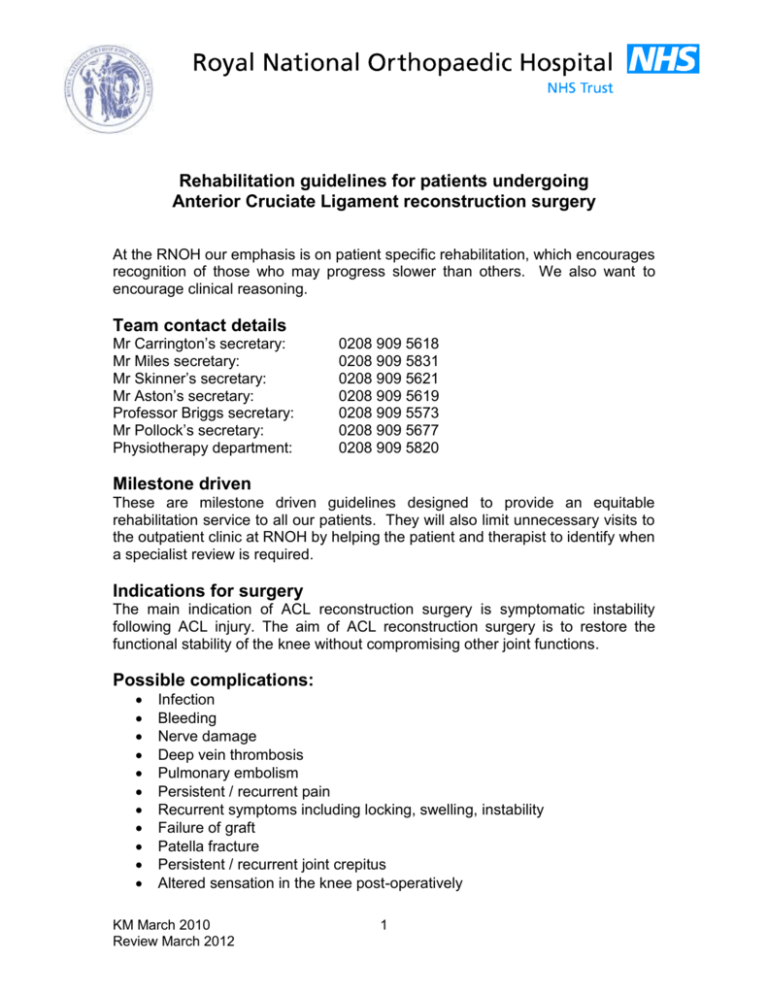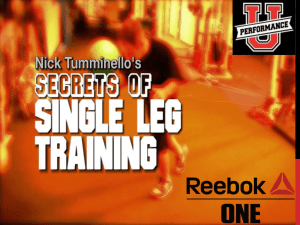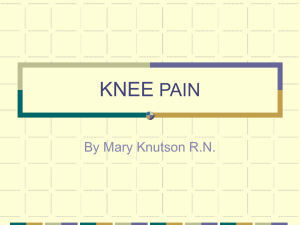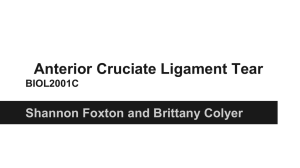Anterior Cruciate Ligament rehabilitation guidelines
advertisement

Rehabilitation guidelines for patients undergoing Anterior Cruciate Ligament reconstruction surgery At the RNOH our emphasis is on patient specific rehabilitation, which encourages recognition of those who may progress slower than others. We also want to encourage clinical reasoning. Team contact details Mr Carrington’s secretary: Mr Miles secretary: Mr Skinner’s secretary: Mr Aston’s secretary: Professor Briggs secretary: Mr Pollock’s secretary: Physiotherapy department: 0208 909 5618 0208 909 5831 0208 909 5621 0208 909 5619 0208 909 5573 0208 909 5677 0208 909 5820 Milestone driven These are milestone driven guidelines designed to provide an equitable rehabilitation service to all our patients. They will also limit unnecessary visits to the outpatient clinic at RNOH by helping the patient and therapist to identify when a specialist review is required. Indications for surgery The main indication of ACL reconstruction surgery is symptomatic instability following ACL injury. The aim of ACL reconstruction surgery is to restore the functional stability of the knee without compromising other joint functions. Possible complications: Infection Bleeding Nerve damage Deep vein thrombosis Pulmonary embolism Persistent / recurrent pain Recurrent symptoms including locking, swelling, instability Failure of graft Patella fracture Persistent / recurrent joint crepitus Altered sensation in the knee post-operatively KM March 2010 Review March 2012 1 Surgical techniques : Various techniques may be used eg. Patella tendon or hamstring graft. The graft substance could be: Autograft : involves the grafting of bone or tissue from the patient’s body. The patella tendon, hamstrings and achilles tendon are autografts used. Allograft : is the use of bone or tissue from a donor’s (typically a cadaver’s body) body. Expected outcome: Improved knee stability Improved function / mobility Reduced pain Full recovery and return to sport may take up to twelve months Pre-operatively: Where possible the patient will be seen pre-operatively, and with consent, the following assessed: Current functional levels General Health Social / Work / Hobbies Functional range of movement Balance / Proprioception- note: a knee brace may be provided if the patient is proprioceptively deficient in the affected knee pre-operatively, otherwise braces are usually not required post-operatively Gait / mobility, including walking aids, orthoses Post-operative expectations Patient information leaflet issued Post-operative management explained Post-operatively: Always check the operation notes, and the post-operative instructions. Discuss any deviation from routine guidelines with the team concerned. KM March 2010 Review March 2012 2 Initial rehabilitation phase In-patient stay (usually 0-3 days) Goals: To be safely and independently mobile with appropriate walking aid/s, adhering to weight bearing as tolerated status To achieve full knee extension and knee flexion to 90° To be independent with home exercise programme To understand self management / monitoring Restrictions: If sedentary employment, may be able to return to work from 2-4 weeks post-operatively, as long as provisions are made to elevate leg, and no complications No Open Kinetic Chain (OKC) quads work If patient has a quads lag on straight leg raise (SLR) then unaffected leg to assist affected leg on and off the bed Treatment: Pain-relief: Ensure adequate analgesia Advice / Education: Teach how to monitor sensation, colour, circulation, temperature, swelling, and advise what to do if concerned. Teach protection, rest, icing, compression and elevation (PRICE). Swelling management Exercises: Example exercises Isometric quads/gluts/hamstrings Knee range of movement exercises to achieve full range of extension and 90° flexion Ankle range of movement exercises Close Kinetic Chain (CKC) quads work Gait re-education: Ensure safe and independently mobile with appropriate walking aid/s Mobility: Ensure patient is independent with transfers and mobility, including stairs if necessary Brace: If required, to ensure brace fits and patient understands how to don and doff brace as appropriate KM March 2010 Review March 2012 3 On discharge from the ward: Independent and safe mobilising with appropriate walking aid/s, including safety on stairs if appropriate Independent and safe with home exercise programme Achieving full range of knee extension and 90° flexion Independent with swelling management Ongoing out-patient physiotherapy arranged for within 2 weeks post op KM March 2010 Review March 2012 4 Initial rehabilitation phase 0-2 weeks Goals: Achieving full range of knee extension to 120° knee flexion Minimal joint effusion (particularly am) Full quadriceps activation Full weight bearing with mobility aid/s at 2 weeks Restrictions: If sedentary employment, may be able to return to work from 2-4 weeks post-operatively, as long as provisions are made to elevate leg, and no complications No OKC quads work Treatment: Pain Relief: Ensure adequate analgesia Advice / Education: Comprehensive education and instruction on restrictions and on carrying out activities of daily living to manage pain and swelling Posture advice / education Swelling management Gait re-education & Mobility: to ensure safely and independently mobile with walking aid/s and to progress weight bearing status to FWB at 2/52 post op if knee control, pain and swelling allows Stretches of tight structures as appropriate Exercises: Example exercises Knee range of movement exercises to ensure achieving full range of extension and progressing range of movement into flexion Stationary cycling can be introduced at 2/52 post op as long as resistance is minimal and there is sufficient ROM to complete a revolution without pain Strengthening of muscles stabilizing the knee i.e. closed kinetic chain quadriceps exercises in prone, open kinetic chain hamstring exercises Manual therapy: o Soft tissue techniques as appropriate. o Joint mobilisations as appropriate ie patella mobilisations and to educate patient to continue independently Hydrotherapy if appropriate Pacing advice as appropriate KM March 2010 Review March 2012 5 Brace: Ensure brace fits and patient understands how to don and doff as appropriate Electrotherapy: if appropriate Milestones to progress to next phase: Achieving full range of knee extension to 120° flexion Minimal joint effusion (particularly am) Full quadriceps activation (full isometric contraction and no quads lag on SLR when assessed by physiotherapist) Full weight bearing with mobility aid/s 2- 6 weeks Goals: Achieving full active range of knee movement Minimal activity related joint effusion Wean from mobility aids as comfort, swelling and knee control allows, to achieve no gait abnormalities Symmetry on ascending and descending stairs Restrictions: If sedentary employment, may be able to return to work from 2-4 weeks post-operatively, as long as provisions are made to elevate leg, and no complications If manual employment may be able to return to work after 6 weeks with pacing provided no complications Driving: May be able to return to driving a manual car if mobilising with no aids, has full range of movement of the knee joint and would be able to perform an emergency stop. May be able to return to driving an automatic car sooner, if the braking pedal is used by the unaffected leg. In both situations must be educated and understand pacing up of driving and general activities to manage pain and swelling No OKC quads work Treatment: Pain Relief: Ensure adequate analgesia Advice / Education: Comprehensive education and instruction on restrictions and on carrying out activities of daily living to manage pain and swelling Posture advice / education Swelling management Gait re-education KM March 2010 Review March 2012 6 Mobility: Ensure safely and independently mobile with walking aid/s progressing to safe and independently mobile without mobility aid/s Exercises: Example exercises Stationary cycling can be introduced as long as resistance is minimal and there is sufficient ROM to complete a revolution without pain. Progress resistance and duration as appropriate Swimming can be commenced once there is satisfactory wound healing, but not breast stroke leg kick Strengthening of muscles stabilizing the knee progressing resistance with theraband/weights and/or COG shift as appropriate Core stability and gluteal control work Balance/Proprioceptive exercises progressing to an unstable BOS and COG shift as appropriate Stretches of tight structures as appropriate Biofeedback may be used if altered sequencing of muscles Manual therapy: o Soft tissue techniques as appropriate o Joint mobilisations as appropriate Hydrotherapy if appropriate Pacing advice as appropriate Brace: Wean from brace once gained sufficient proprioceptive control and strength around the knee Electrotherapy: if appropriate Milestones to progress to next phase: Achieving full range of knee movement Minimal activity related joint effusion Unilateral CKC squat with knee valgus control Step up with knee valgus control Single leg stance eyes open R=L KM March 2010 Review March 2012 7 Recovery rehabilitation phase 6 weeks – 12 weeks Goals: Bilaterally equal propriocepton tests on single leg stance Bilaterally equal strength of hamstrings, hip adductors, hip abductors and gastrocnemius Restrictions: No jogging until proprioception on an uneven surface, knee valgus control when leaping and unilateral CKC squat with knee valgus control is achieved. This can be expected to be at approximately 12 weeks post op If manual employment may be able to return to work after 6 weeks with pacing provided no complications No OKC quadriceps work until 12 weeks post op Treatment: Pain Relief: Ensure adequate analgesia Advice / Education: Comprehensive education and instruction on restrictions and on carrying out activities of daily living to manage pain and swelling Posture advice / education Swelling management Mobility: Ensure safely and independently mobile without walking aid. Exercises Example exercises Rowing machine can be introduced progressing resistance and duration as appropriate Stepper can be introduced progressing resistance and duration as appropriate Road cycling can be introduced progressing duration as appropriate Balance / Proprioception progress unilateral exercises with unstable BOS and COG shift Strengthening of muscles stabilising the knee progressing resistance with theraband/weights and/or COG shift as appropriate Strengthening exercises of other muscle groups as appropriate Core stability and gluteal control work Stretches of tight structures as appropriate to ensure normal flexibility of quadriceps, hamstrings and calf muscles Review lower limb biomechanics and kinetic chain, addressing issues as appropriate Biofeedback may be used if altered sequencing of muscles KM March 2010 Review March 2012 8 Manual therapy: o Soft tissue techniques as appropriate o Joint mobilisations as appropriate Hydrotherapy if appropriate Pacing advice as appropriate Brace: Wean from brace once gained sufficient proprioceptive control and strength around the knee Electrotherapy: if appropriate Milestones to progress to next phase: Bilaterally equal propriocepton tests on single leg stance Bilaterally equal strength of hamstrings, hip adductors, hip abductors and gastrocnemius KM March 2010 Review March 2012 9 Intermediate – final rehabilitation phase 12 weeks – 1 year Goals: 1RM single leg press relative strength index (RSI) greater than or equal to 125% Leg symmetry Index (LSI) 85% - 100% of knee extensors Symmetry on hop tests Graded return to sport if set as patient goal, when has satisfied functional performance testing requirements and when consultant has agreed for patient to return to sport No contact sports for 6 months post op Establish long term maintenance programme Restrictions: Return to sport when has satisfied functional performance testing requirements and when consultant has agreed for patient to return to sport No contact sports for 6 months post op Treatment: Advice / Education Posture advice / education Mobility: progression of mobility and function Exercises: Jogging progressing to change of direction and rotation component as appropriate Swimming breast stroke leg kick can be introduced from 4/12 post op Plyometrics Jump training Agility training Hop tests Strengthening through range to include OKC quadriceps if appropriate, commence outer range first and progressing to inner range Introduction of sports specific and occupation specific rehabilitation Core stability and gluteal control work Stretches of tight structures as appropriate Review lower limb biomechanics and kinetic chain, addressing issues as appropriate Balance / Proprioception work progressing to unstable BOS and COG shift Progress from static to dynamic exercises as appropriate Manual Therapy: KM March 2010 Review March 2012 10 o Soft tissue techniques as appropriate o Joint mobilisations as appropriate Hydrotherapy if appropriate Pacing advice as appropriate Brace: Wean from brace once gained sufficient proprioceptive control and strength around the knee Electrotherapy: if appropriate Milestones for discharge: Good proprioceptive control dynamically Return to normal functional level Satisfied criteria for functional testing and return to sports if set as patient goal Failure to meet milestones: Refer back to team / Discuss with team Continue with outpatient physiotherapy if still progressing and appropriate goals KM March 2010 Review March 2012 11 Failure to progress If a patient is failing to progress, then consider the following: Possible problem Swelling Pain Breakdown of wound inflammation, bleeding, infection Recurrent Instability Numbness / altered sensation KM March 2010 Review March 2012 Action Ensure elevating leg regularly. Use ice as appropriate if normal skin sensation and no contraindications. Decrease amount of time on feet. Pacing. Use walking aids. Circulatory exercises. Modify exercise programme as appropriate. Should continue isometric work at all times. If decreases overnight, monitor closely. If does not decrease over a few days, refer back to surgical team Decrease activity. Ensure adequate analgesia. Elevate regularly. Decrease weight bearing and use walking aids as appropriate. Pacing. Modify exercise programme as appropriate. Should continue isometric work at all times. If persists, refer back to surgical team. e.g. Refer to surgical team. Refer back to surgical team. Ensure exercise progressions are at suitable level for patient. Address core stability. Review immediate post-operative status if possible. Ensure swelling under control. If new onset or increasing refer back to surgical team. If static, monitor closely, but inform surgical team and refer back if deteriorates or if concerned. 12 Appendix Calculation of Limb Symmetry Index LSI (%) = injured limb score ÷ uninjured limb score × 100 Calculation of Relative Strength Index RSI (%) = weight pushed (kg) ÷ bodyweight (kg) × 100 Summary of evidence for physiotherapy guidelines A comprehensive literature search was carried out to identify research relating to rehabilitation following Anterior Cruciate Ligament reconstruction of the knee. After reviewing the articles and information, and discussion with the consultants and therapists at the RNOH, the physiotherapy guidelines were produced on the best available evidence. Clark N (2001) Functional performance testing following knee ligament injury. Phyysical Therapy in Sport 2, 91-105. Herrington L et al (2009) A comparison of the Star Excursion Balance Test reach distances between ACL deficient patients and asymptomatic controls. The Knee 16 149-152. Mc Devitt et al (2005) Functional Bracing Was No Better Than Nonbracing After Anterior Cruciate Ligament Repair. The Journal of Bone & Joint Surgery Volume 87-A Number 8 Myer G et al (2008) Neuromuscular training techniques to target deficits before return to sport after anterior cruciate ligament reconstruction. Journal of Strength and Conditioning Research 22(3) 987-1014 Risberg et al (2007) Neuromuscular Training Versus Strength Training During First 6 Months After Anterior Cruciate Ligament Reconstruction: A Randomized Clinical Trial. Physical Therapy Volume 87 Number 6 Shelbourne D & Klotz C (2006) What I have learned about the ACL: utilizing a progressive rehabilitation scheme to achieve total knee symmetry after anterior cruciate ligament reconstruction. Journal of Orthopaedic Science 11: 318-325. Shelbourne D & Rask B (1998) Controversies With Anterior Cruciate Ligament Surgery and Rehabilitation. The American Journal of Knee Surgery Vol 11 No 2 KM March 2010 Review March 2012 13 Tyler T & McHugh M (2001). Neuromuscular Rehabilitation of a Female Olympic Ice Hockey Player Following Anterior Cruciate Ligament Reconstruction. Journal of Orthopaedic & Sports Physical Therapy 31 (10): 577-587. KM March 2010 Review March 2012 14







